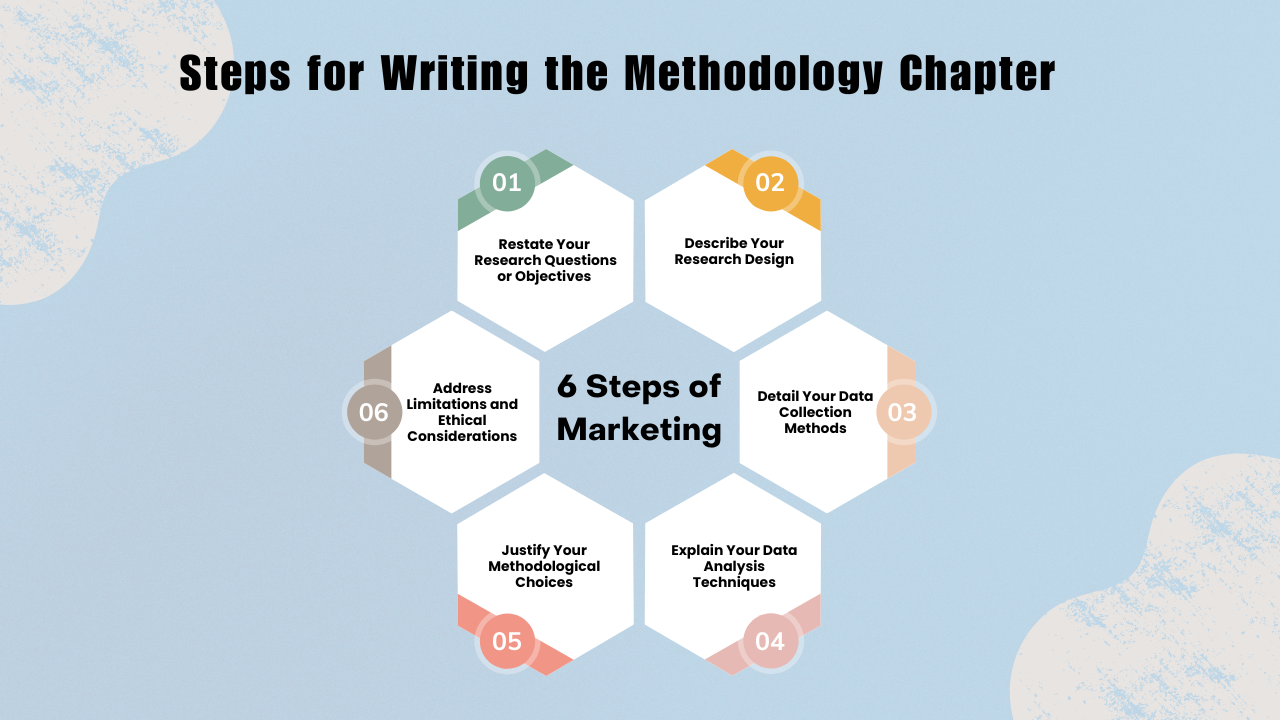The Ultimate Guide to Writing the Methodology Chapter for Your PhD
Kenfra Research - Bavithra2025-08-06T11:18:20+05:30When crafting your thesis or dissertation, writing the methodology chapter is one of the most crucial steps. This chapter explains the research methods you chose, justifies why they’re appropriate, and shows how they align with your research approach. Whether you’re working on a qualitative, quantitative, or mixed methods study, a well-written methodology builds credibility and clarity into your academic work.
In this blog, we’ll explore how to write the methodology chapter across different research designs, highlight essential components, and guide you on what to include for each approach.
Let’s dive into the structured process of writing the methodology chapter for your academic success.
Research Methodology
What Is a Research Methodology Chapter?
The research methodology chapter is a section of your thesis or dissertation that outlines how your research was conducted. It includes your overall research design, data collection and analysis methods, and the justification for your choices.
A well-developed methodology chapter for PhD research also anticipates possible challenges and explains how you mitigated bias, ensuring your study is both reliable and valid.
Why Is It Important?
The methodology section of a dissertation provides transparency. It allows other researchers to replicate your work or assess its reliability. If you’re submitting your work to a university or academic journal, this section is often scrutinized in detail.
At Kenfra Research, we often help scholars refine their methodology sections to ensure consistency, logic, and academic rigor.
Writing the Methodology Chapter: Step-by-Step Guide

1. Restate Your Research Questions or Objectives
Start by reminding readers of your goals. This aids in placing the decisions you make during your research process in context.
2. Describe Your Research Design
Is your approach qualitative, quantitative, or mixed methods? Clearly describe your design and the reasons it works for your research.
3. Detail Your Data Collection Methods
Explain how you gathered data—surveys, interviews, experiments, or secondary data. Mention instruments used, sampling methods, and criteria.
4. Explain Your Data Analysis Techniques
Describe how you analyzed the data (statistical tools, coding strategies, etc.) and how this aligns with your research methodology.
5. Justify Your Methodological Choices
Show why you chose this design over others. Cite sources or prior studies if possible.
6. Address Limitations and Ethical Considerations
Be transparent about limitations and how you handled ethical issues like informed consent or data privacy.
Methodology for Different Research Approaches
Writing Methodology for Qualitative Research
This approach explores meanings, concepts, and lived experiences.
- Use interviews, focus groups, or observations.
- Mention coding frameworks like thematic analysis.
- Reflect on subjectivity and researcher involvement.
- Example: Phenomenological or ethnographic methods.
Methodology Writing for Quantitative Research
Methodology Writing for Quantitative Research involves explaining how numerical data is collected and analyzed to test hypotheses. This approach uses surveys, experiments, or pre-existing datasets to gather measurable data. Clearly define your variables, outline your research hypotheses, and specify the statistical tools used for analysis, such as regression analysis, ANOVA, or descriptive statistics. Emphasize the importance of objectivity, standardization, and replicability to ensure reliability. Each step should demonstrate how your chosen methods align with your research questions and contribute to producing valid, generalizable results within your field of study.
Writing Methodology Chapter for Mixed Methods Research
Combines qualitative and quantitative techniques.
- Describe integration: sequential, concurrent, or transformative.
- Justify why both methods were necessary.
- Provide timelines for each phase.
- Mention how findings complement each other.

What to Include in a Thesis Methodology Chapter
A well-structured thesis methodology chapter should clearly present the type of research approach used—qualitative, quantitative, or mixed methods. It must detail the data collection methods and sampling techniques, specifying how participants or data sources were selected. Include the tools and techniques for data analysis, whether statistical software, coding methods, or thematic frameworks. Address any ethical considerations, such as consent and data privacy, and outline potential challenges faced during research. Justify all methodological choices with logical reasoning or literature support. Finally, acknowledge the limitations of your approach and explain how they were managed to maintain research credibility.
Examples of Methodology Chapter for Different Research Designs
- Qualitative Example:
“A phenomenological approach was adopted to explore the lived experiences of migrant women…” - Quantitative Example:
“A cross-sectional survey was conducted among 200 participants using a structured questionnaire…” - Mixed Methods Example:
“The study employed an explanatory sequential design where quantitative results guided the qualitative interviews…”
Conclusion
Writing the methodology chapter is not just about describing your research methods—it’s about justifying them. Whether you’re using a qualitative, quantitative, or mixed methods approach, clarity, transparency, and alignment with your objectives are key.
A well-structured methodology chapter for PhD or Master’s research adds credibility and helps you stand out. If you need expert guidance, Kenfra Research is here to help you at every stage of your research journey.








Leave a Reply